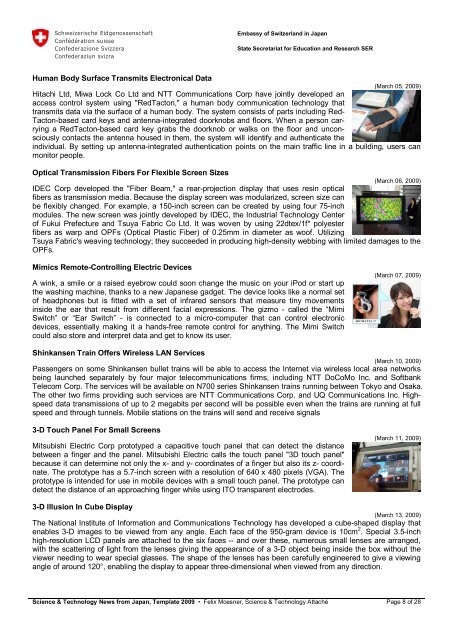Science & Technology News from Japan - International Relations
Science & Technology News from Japan - International Relations
Science & Technology News from Japan - International Relations
You also want an ePaper? Increase the reach of your titles
YUMPU automatically turns print PDFs into web optimized ePapers that Google loves.
Schweizerische Eidgenossenschaft<br />
Confédération suisse<br />
Confederazione Svizzera<br />
Confederaziun svizra<br />
Human Body Surface Transmits Electronical Data<br />
Embassy of Switzerland in <strong>Japan</strong><br />
State Secretariat for Education and Research SER<br />
(March 05, 2009)<br />
Hitachi Ltd, Miwa Lock Co Ltd and NTT Communications Corp have jointly developed an<br />
access control system using "RedTacton," a human body communication technology that<br />
transmits data via the surface of a human body. The system consists of parts including Red-<br />
Tacton-based card keys and antenna-integrated doorknobs and floors. When a person carrying<br />
a RedTacton-based card key grabs the doorknob or walks on the floor and unconsciously<br />
contacts the antenna housed in them, the system will identify and authenticate the<br />
individual. By setting up antenna-integrated authentication points on the main traffic line in a building, users can<br />
monitor people.<br />
Optical Transmission Fibers For Flexible Screen Sizes<br />
(March 06, 2009)<br />
IDEC Corp developed the "Fiber Beam," a rear-projection display that uses resin optical<br />
fibers as transmission media. Because the display screen was modularized, screen size can<br />
be flexibly changed. For example, a 150-inch screen can be created by using four 75-inch<br />
modules. The new screen was jointly developed by IDEC, the Industrial <strong>Technology</strong> Center<br />
of Fukui Prefecture and Tsuya Fabric Co Ltd. It was woven by using 22dtex/1f* polyester<br />
fibers as warp and OPFs (Optical Plastic Fiber) of 0.25mm in diameter as woof. Utilizing<br />
Tsuya Fabric's weaving technology; they succeeded in producing high-density webbing with limited damages to the<br />
OPFs.<br />
Mimics Remote-Controlling Electric Devices<br />
A wink, a smile or a raised eyebrow could soon change the music on your iPod or start up<br />
the washing machine, thanks to a new <strong>Japan</strong>ese gadget. The device looks like a normal set<br />
of headphones but is fitted with a set of infrared sensors that measure tiny movements<br />
inside the ear that result <strong>from</strong> different facial expressions. The gizmo - called the “Mimi<br />
Switch” or “Ear Switch” - is connected to a micro-computer that can control electronic<br />
devices, essentially making it a hands-free remote control for anything. The Mimi Switch<br />
could also store and interpret data and get to know its user.<br />
(March 07, 2009)<br />
Shinkansen Train Offers Wireless LAN Services<br />
(March 10, 2009)<br />
Passengers on some Shinkansen bullet trains will be able to access the Internet via wireless local area networks<br />
being launched separately by four major telecommunications firms, including NTT DoCoMo Inc. and Softbank<br />
Telecom Corp. The services will be available on N700 series Shinkansen trains running between Tokyo and Osaka.<br />
The other two firms providing such services are NTT Communications Corp. and UQ Communications Inc. Highspeed<br />
data transmissions of up to 2 megabits per second will be possible even when the trains are running at full<br />
speed and through tunnels. Mobile stations on the trains will send and receive signals<br />
3-D Touch Panel For Small Screens<br />
Mitsubishi Electric Corp prototyped a capacitive touch panel that can detect the distance<br />
between a finger and the panel. Mitsubishi Electric calls the touch panel "3D touch panel"<br />
because it can determine not only the x- and y- coordinates of a finger but also its z- coordinate.<br />
The prototype has a 5.7-inch screen with a resolution of 640 x 480 pixels (VGA). The<br />
prototype is intended for use in mobile devices with a small touch panel. The prototype can<br />
detect the distance of an approaching finger while using ITO transparent electrodes.<br />
(March 11, 2009)<br />
3-D Illusion In Cube Display<br />
(March 13, 2009)<br />
The National Institute of Information and Communications <strong>Technology</strong> has developed a cube-shaped display that<br />
enables 3-D images to be viewed <strong>from</strong> any angle. Each face of the 950-gram device is 10cm 2 . Special 3.5-inch<br />
high-resolution LCD panels are attached to the six faces -- and over these, numerous small lenses are arranged,<br />
with the scattering of light <strong>from</strong> the lenses giving the appearance of a 3-D object being inside the box without the<br />
viewer needing to wear special glasses. The shape of the lenses has been carefully engineered to give a viewing<br />
angle of around 120°, enabling the display to appear three-dimensional when viewed <strong>from</strong> any direction.<br />
<strong>Science</strong> & <strong>Technology</strong> <strong>News</strong> <strong>from</strong> <strong>Japan</strong>, Template 2009 • Felix Moesner, <strong>Science</strong> & <strong>Technology</strong> Attaché Page 8 of 28
















